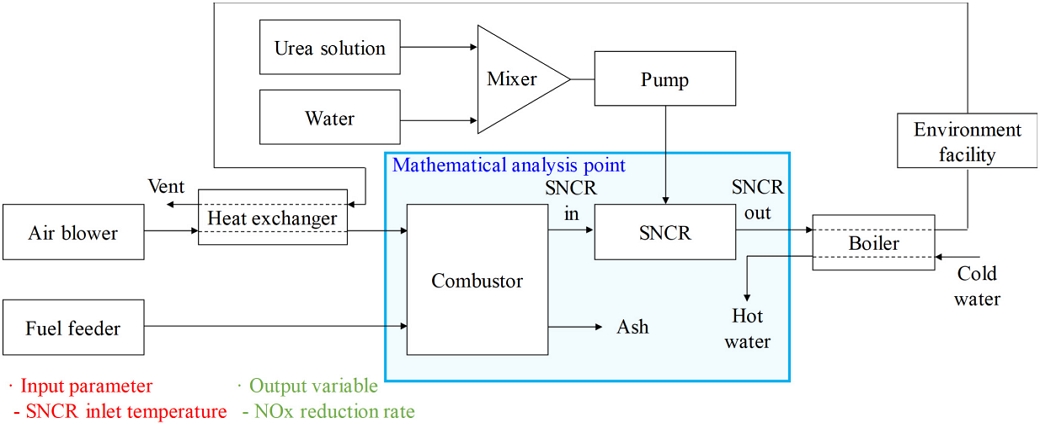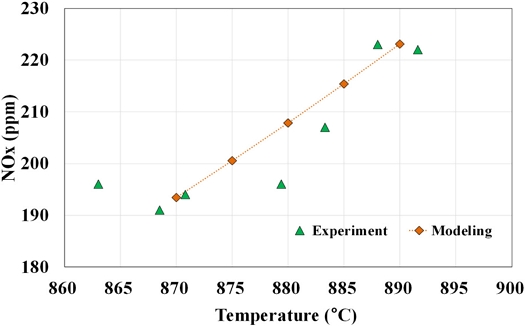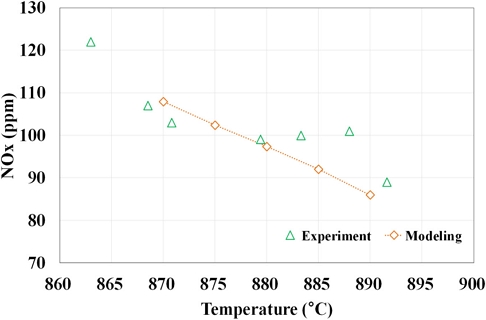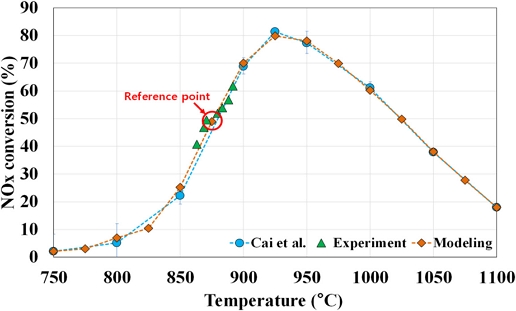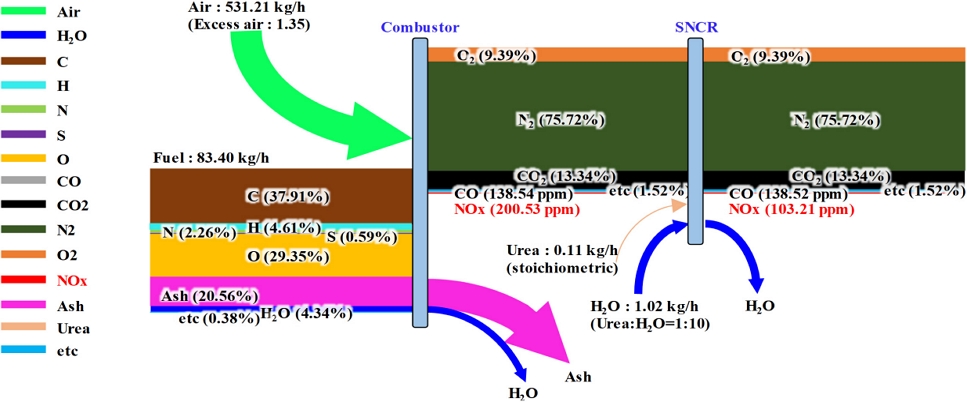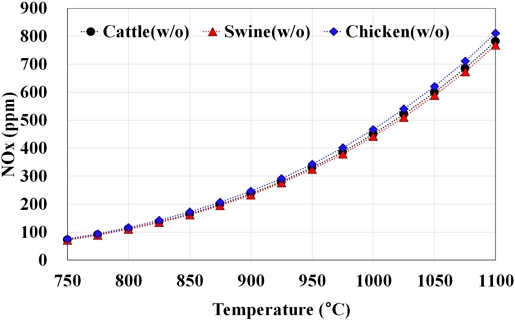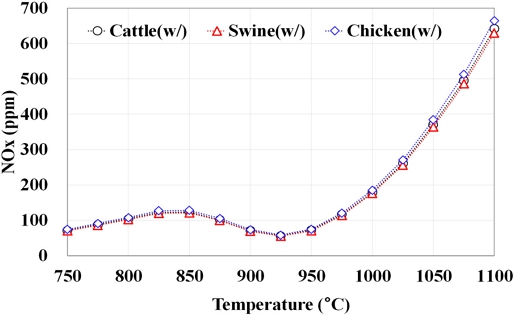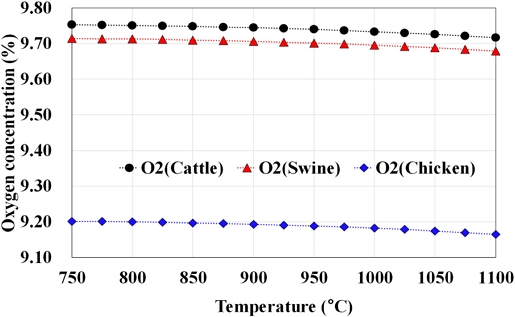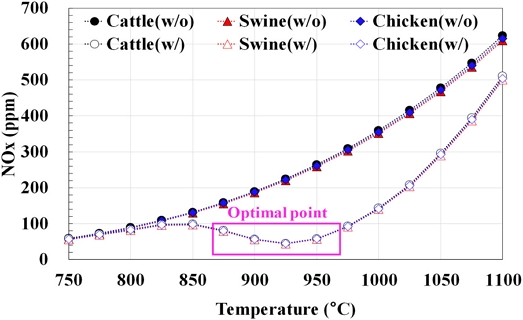
Online publication date 16 Aug 2024
우레아 기반 SNCR 적용에 따른 가축분뇨 고체연료 배기가스 NOx 저감에 대한 전산해석
Copyright © 2024 by the New & Renewable Energy
This is an Open Access article distributed under the terms of the Creative Commons Attribution Non-Commercial License (http://creativecommons.org/licenses/by-nc/4.0) which permits unrestricted non-commercial use, distribution, and reproduction in any medium, provided the original work is properly cited.
Abstract
Livestock manure solid fuel has been studied as a promising domestic energy resource for reducing greenhouse gas emissions in agricultural fields. To successfully commercialize this technology, the environmental facilities require optimization in accordance with domestic environmental standards. In the present study, a computational analysis model of a livestock manure solid fuel boiler system was developed using Aspen Plus® to investigate nitrogen oxides (NOx) emissions and NOx conversion efficiency using urea-based selective non-catalytic reduction (SNCR). All data were compared across different livestock species and simulated at various operating temperatures. The simulation showed that NOx emissions were the highest from chicken manure and the lowest from swine manure. However, when converted to an oxygen concentration of 12%, NOx emissions were the highest from cattle manure. Dominant factors influencing NOx emissions through a range of temperatures were analyzed, and the optimal operating temperature range (875-950°C) was derived.
Keywords:
Livestock manure, Solid fuel, Nitrogen oxides, Selective non-catalytic reduction, Computational analysis키워드:
가축분뇨, 고체연료, 질소산화물, 선택적 무촉매 환원법, 전산해석1. 서 론
우리나라 총 온실가스 배출량은 2021년 기준 약 676.6 백만톤이며,[1] 그 중 농업부문 배출량은 약 21.4 백만톤으로 전체 배출량의 3%를 차지한다.[2] 농업부문 전체 배출량 중 축산부문이 46.2%를 차지하며, 그 중 절반인 51%가 가축분뇨처리과정에서 발생하는 메탄(CH4)과 아산화질소(N2O)이다.[3] 국내 1인당 육류 소비량은 지속적으로 증가하고 있으며,[4] 이에 따른 사육두수 및 축산부문 온실가스 배출량 또한 증가할 것으로 전망되어, 축산부문 온실가스 배출량 감축을 위한 가축분뇨 처리방식의 개선이 필요하다. 기존 가축분뇨 주요 처리방법인 퇴·액비화[5] 방식을 에너지화 등으로 다각화하여 퇴·액비 살포과정에서 발생하는 온실가스의 저감이 필요하며, 현재 관련 정부부처를 중심으로 가축분뇨 에너지 전환 사업이 진행 중이다.[6]
가축분뇨를 에너지자원으로 활용하는 여러 방법 중 대표적인 사례로 고체연료화가 있으며,[7] 최근 가축분뇨 고체연료를 에너지원으로 활용하기 위한 여러 연구가 수행되고 있다. 이 등은 축종별 가축분뇨 고체연료의 공업분석, 원소분석을 통해 연료로써의 가치를 확인하였으며,[8,9] 정 등은 우분 고체연료 열중량 분석과 열분해 실험을 통해 연소 특성을 파악하고 연소재의 흡착성 재료 및 비료로써의 활용 가능성을 제시하였다.[10] Szymajda et al.(2021)은 우분 고체연료의 겉보기 밀도, 입자 밀도 및 연소 배기가스, 소각재의 조성을 분석하여 농업분야에서 축분 고체연료가 저비용 연료로 이용될 수 있음을 제시하였으며,[11] Oshita et al.(2015)은 액화 다이메틸 에터(Liquefied Dimethyl Ether, DME)를 이용한 우분 함수율 최대 98% 제거 및 이를 활용한 고체연료 생산에 대한 연구를 수행하였다.[12]
석탄 등 화석연료 대신 가축분뇨 고체연료와 같은 바이오매스를 연소하거나, 석탄과의 혼합 연소를 하면 연료비용뿐만 아니라 질소산화물(NOx)과 같은 대기오염물질 및 화석연료 사용으로 인해 발생하는 이산화탄소(CO2)까지 저감 가능하다.[13~15] 하지만, 바이오매스를 연소하는 과정에서도 대기오염물질은 발생하며,[16] 대기오염물질 저감장치 등 관련 정제설비 구성을 통하여 대기환경보전법 시행규칙 내 “대기오염물질의 배출허용기준”을 충족하여 최종 배출하여야 한다. 일산화질소(NO), 이산화질소(NO2), 아산화질소(N2O), 삼산화이질소(N2O3), 사산화이질소(N2O4), 오산화이질소(N2O5)로 이루어진 질소산화물은 연료의 연소과정에서 발생하는 일차오염물질이며,[17] 질소산화물 중 95% 이상은 NO로 구성되어 있다.[18] NO가 대기 중에 노출될 경우, 광화학반응을 통해 폐와 기관지 등에 악영향을 미치는 광화학산화물인 NO2와 오존(O3)이 최종적으로 발생한다.[19,20] NOx 배출량 저감을 위해서는 선택적 촉매환원법(Selective Catalytic Reduction, SCR) 및 선택적 무촉매환원법(Selective Non-Catalytic Reduction, SNCR)과 같은 배연탈질 기술의 적용이 필요하다.[21] SCR은 약 200°C~350°C 온도 범위에서 구동하며 TiO2, V2O5, WO3과 같은 촉매표면에서 암모니아(NH3)와의 반응을 통해 NOx를 저감하는 기술로, 90% 이상의 높은 NOx 저감 효율을 보인다.[22] SNCR은 약 850°C~1000°C 온도 범위에서 구동하며 암모니아 혹은 우레아(NH2CONH2)와 반응하여 NOx를 저감하는 기술로, SCR에 비해 탈질효율은 낮지만 가격적 측면에서 이점이 있는 기술이다.[23] 농가에서 가축분뇨 고체연료 기반 바이오매스 연소 보일러를 이용할 경우, 비용 및 운영 측면에서 현실적으로 SCR 적용이 어렵기 때문에, 가축분뇨 고체연료 연소조건에 따른 SNCR 탈질효율 최적화가 연구가 수행되어야 한다.
본 연구에서는 축종별(소, 돼지, 닭) 가축분뇨 고체연료 연소 시 NOx 발생량에 대한 예측 및 우레아 기반 SNCR을 보일러 연소실 후단에 적용하였을 때 최종 NOx 배출량을 분석할 수 있는 전산해석 모델을 공정모사 프로그램인 Aspen Plus®을 이용하여 개발하였다. 연소온도에 따른 축종별 NOx 발생량 및 SNCR 적용에 따른 NOx 최종 배출량을 분석하였으며, 국내 대기환경보존법을 충족할 수 있는 보일러 작동조건을 도출하였다. 본 연구 결과는 향후 국내 가축분뇨 기반 바이오매스 연소 기술 활성화를 위한 기반 자료로 활용될 수 있다.
2. 시스템 구성도
전반적인 시스템 구성은 Fig. 1과 같다. 가축분뇨 고체연료는 스크류 피더를 통해 연소실로 공급되고, 공기는 블로워를 통해 연소실로 공급되며, 공기는 연소실 인입 전 공기예열기를 통해 1차 가열된다. 연소로는 화격자 연소방식으로 구성되어 있으며, 화격자를 통해 연료가 서서히 연소하면서 열에너지를 생산한다. 소각재는 하부 스크류를 통해 외부 저장고로 배출되며, 고온의 연소가스는 연소실 후단에서 10% 수준으로 희석된 우레아 수용액과의 접촉을 통해 탈질반응이 발생하면서 NOx가 저감된다. 이후, 배기가스는 보일러에서 물과 열교환을 통해 온수를 생산하고, 사이클론, 백필터 등의 환경설비를 통해 대기오염물질을 저감한 후 최종 배출된다. 개발한 전체 시스템 모델 중에서 파란색으로 표기된 영역이 본 연구에서 집중적으로 분석한 전산해석 지점이다.
3. 모델링
3.1 축분 고체연료
SNCR 전산해석 모델의 유효성 검증을 위하여, 실험에 이용된 연료와 동일한 조성으로 연료를 모델링하였고 동일조건에서 결과를 비교하였다. 실험에 이용된 연료는 천안 젖소 농가에서 채취한 시료로 제조한 우분 고체연료이며, 물성은 Table 1과 같다.[24]
위 물성은 고형연료제품 품질 시험·분석방법(환경부 고시 제2020-219호)을 표준으로 적용한 발열량, 공업분석, 원소분석 결과이다.[8,9]
가축분뇨 고체연료는 축종 및 사육환경에 따라 구성 성분의 편차가 타 연료에 비해 상당히 크다. 그렇기에 여러 문헌조사를 통해 축종별 4건의 물성 데이터를 추출하였고, 각 축종의 평균값을 기반으로 연료 모델링을 진행했다. 모델링에 이용한 축종별 연료 물성 데이터는 Table 2와 같다. 문헌에 명기된 물성 데이터들의 표기 조건이 상이하여 수분(Water Content, WC), 휘발분(Volatile Solids, VS), 회분(Ash), 고정탄소(Fixed Carbon, FC)의 합은 100%가 되도록, 탄소(C), 수소(H), 산소(O), 질소(N), 황(S), 염소(Cl), 회분(Ash)의 합은 총 고형분(Total Solid, TS=VS+FC+Ash)이 되도록 데이터 표기 조건을 통일하였다. 평균 데이터상 우분 고체연료 내 탄소 함량이 35.65%로 가장 높았으며, 그다음으로 돈분이 35.19%이었고, 계분이 33.67%로 가장 낮았다. 반면 질소 함량은 계분이 3.68%로 가장 높았고, 그다음으로 돈분이 2.33%이었으며, 우분이 1.47%로 가장 낮았다.
3.2 축분 고체연료 연소 보일러
가축분뇨 고체연료 내 가연성분인 탄소, 수소, 황은 고온의 연소실에 공급된 공기 중 산소와의 연소반응을 통해 열에너지를 생산한다. 연소로는 Aspen Plus®에 내장된 RStoic block을 이용하여 모델링하였으며, 해당 block에서 고려한 연소 반응식은 다음 식 (1)~(3)과 같다.[34,35]
| (1) |
| (2) |
| (3) |
위 가연성분들의 연소를 위해서는 산소가 공급되어야 하며, 연소반응에 필요한 이론 산소량은 아래 식 (4)와 같다.
| (4) |
Ot는 이론 산소량이다. 위 계산식은 질량에 대한 식이며, 연료 중의 산소와 이미 결합하고 있어 연소반응에 참여하지 않는 수소를 제외한 유효 수소(Available hydrogen)만을 고려하였다. 이론 산소량을 토대로 이론 공기량을 구하는 식은 식 (5)와 같다.
| (5) |
At는 이론 공기량이며, 투입한 가축분뇨 고체연료의 연소에 필요한 이론적인 공기 투입량이다. 실제 연소 환경에서는 원활한 연소를 위해 공기를 추가 투입하게 되며, 실제로 투입한 공기량인 공기비의 식은 아래 식 (6)과 같다.
| (6) |
α는 공기비, Aa는 실제 공기량이다. α=1은 이론 공기비 조건이고, α > 1은 공기가 과급된 린번(Lean burn) 영역이며, α < 1은 연료가 과도한 리치번(Lean burn) 영역이다.
연소 과정에서 Fuel NOx, Thermal NOx, Prompt NOx 등 다양한 형태로 NOx가 발생하나, 본 모델링에서는 Fuel NOx와 Thermal NOx 두 가지 NOx 생성 반응을 적용하였으며, 생성물로 고려한 성분은 NO, NO2, N2O 총 세 종이다. Fuel NOx는 연소로 반응기로 사용한 RStoic block에 내장된 연소반응을 통해 NO가 생성물로 발생하도록 하였으며, 해당 block에 적용한 반응식은 아래 식 (7)과 같다.[35]
| (7) |
Thermal NOx는 Aspen Plus®에 내장된 REquil block을 이용하여 모델링하였으며, 해당 반응기에 적용한 NOx 생성 반응은 다음 식 (7)~(9)과 같다.[35,36]
| (7) |
| (8) |
| (9) |
연소로에서 발생한 고온의 연소가스는 보일러 내부 순환수와의 열교환을 통해 온수를 생산한다. 축분 고체연료 연소 보일러 모델링에 적용된 보일러 사양은 아래 Table 3과 같다.
SNCR은 촉매없이 암모니아 혹은 우레아를 환원제로 이용하여 NOx를 제거하는 기술로, 반응 온도가 무엇보다 중요한 요소이다. 최적온도 이하로 SNCR이 구동될 경우 NOx 제거율 감소 및 암모니아 슬립이 발생할 수 있고, 최적온도 이상에서 SNCR이 구동될 경우도 마찬가지로 NOx 제거율이 감소하고 환원제 이용률도 감소하는 문제가 발생한다. 본 모델에서는 상용 40% 우레아 수용액에 물을 추가 혼합하여 최종 10% 우레아 용액이 SNCR에 공급되는 것으로 설계되었으며, 본 모델에 적용한 반응식은 아래 식 (10)과 같다.[37]
| (10) |
SNCR은 RStoic block을 이용하여 발생한 NOx의 양론비만큼 우레아 수용액이 투입되도록 모델링했다. SNCR은 반응온도 충족을 위하여 보통 연소실 후단 배관 입구부 혹은 연소실 내부에 설비가 구성되어 있으며, 수용액을 펌프와 노즐을 이용하여 연소가스에 분사한다.
공기 공급을 위한 블로워는 Aspen Plus®에 내장된 Compressor block을 이용하여 모델링하였고, 우레아 공급을 위한 펌프는 Pump block을 이용하였으며, 연소가스 열을 활용한 공기 예열기는 Heater block에 Calculator로 유용도-NTU법(Effectiveness-NTU method)을 내부 Fortran coding하여 대향류(Counter flow)로 열교환 되도록 구성하였다. 모델링에 적용한 기타 구성기기의 효율은 아래 Table 4와 같다.[38]
4. 시뮬레이션
4.1 가정 및 유효성 검증
본 모델에 적용한 주요 가정은 아래와 같다.
- 1) 전체 시스템은 정상상태이다.
- 2) 공급 공기의 조성은 질소 78.08 vol%, 산소 20.95 vol%, 아르곤 0.93 vol%, 이산화탄소 0.04 vol%이다.
- 3) 전체 시스템에서 발생하는 압력강하는 무시한다.
- 4) 온도별 NOx 전환 효율은 연료 조성에 상관없이 동일하다.
- 5) 연료별 공기비는 1.35로 동일하며, 이에 따른 동일 연료 투입량 대비 공기 공급량의 차이가 존재한다.
- 6) 우레아는 탈질반응 양론비에 맞게 공급되며, 공급량 전부 반응에 참여한다.
Table 1의 우분 고체연료를 연소했을 때 온도별 NOx 순 발생량(실험 데이터)과 모델링을 비교한 결과는 아래 Fig. 2와 같다.
실험에서는 연소온도가 868.50°C에서 891.60°C로 증가함에 따라 NOx 발생량이 191 ppm에서 223 ppm으로 증가하였으며, 모델링에서는 온도가 870°C에서 890°C로 증가함에 따라 NOx 발생량이 193.42 ppm에서 223.09 ppm으로 증가하였다. 연소 온도별 실험 데이터의 일차 추세선과 모델링의 최대 오차는 ±5.46 ppm이며, 해당 온도에서 SNCR 적용에 따라 저감된 최종 NOx 배출량을 비교한 결과는 Fig. 3과 같다. 실험에서는 연소온도가 868.50°C에서 891.60°C로 증가함에 따라 NOx 발생량이 107 ppm에서 89 ppm으로 감소하였으며, 모델링은 온도가 870°C에서 890°C로 증가함에 따라 NOx 발생량이 107.91 ppm에서 93.03 ppm으로 감소하였다. 위 조건에서 연소 온도별 실험 데이터의 일차 추세선과 모델링의 최대 오차는 ±7.38 ppm이며, 870°C에서 890°C로 증가함에 따라 모델링의 NOx 전환율은 44.21%에서 61.61%로 증가하였다.
위 실험결과는 863°C에서 891.60°C 사이의 제한된 온도 범위에서의 데이터로, 더 넓은 온도 영역에서의 NOx 전환효율은 계산이 불가능하다. 그렇기에 해당 온도 영역에서 NOx 전환율이 유사하면서 더 넓은 범위(750°C에서 1100°C)까지 실험을 수행한 타 문헌 데이터를 추가적으로 고려하여,[39] 광범위한 연소온도 영역에서 SNCR 적용에 따른 NOx 저감량이 계산 가능하도록 모델을 개발하였다. 실험 데이터들과 개발한 모델의 NOx 전환율을 비교한 유효성 검증 결과는 아래 Fig. 4와 같다.
Cai et al.(2021)이 수행한 우레아 기반 SNCR 실험에서는 750°C부터 1100°C까지 50°C 간격으로 NOx 전환율을 분석하였으며,[39] 변곡 구간인 925°C에서의 NOx 전환율도 계측하였다. 하지만, 해당 연구에서는 NOx 발생량 및 SNCR 적용에 따른 최종 NOx 배출량에 대한 데이터는 제공하지 않고, NOx 전환률에 대한 수치만 제시하였다. 해당 연구 데이터에서는 750°C부터 925°C까지 증가하는 구간에서 NOx 전환율이 2.12%에서 81.38%로 증가하였으며, 온도가 925°C 이상 높아지는 구간부터는 NOx 전환율이 감소하기 시작하여 1100°C에서는 NOx 전환율이 17.99%까지 감소하였다. 본 모델링에서는 750°C부터 925°C까지의 구간에서는 NOx 전환율이 2.19%에서 79.90%까지 증가하였으며, 1100°C에서는 NOx 전환율이 18.01%까지 감소하였다. 그래프 내 Reference point는 모델링 기준점이며, 기준조건에서 연소 및 탈질반응에 따른 반응물과 생성물의 물질수지 및 조성 변화는 Fig. 5와 같다. 우분 고체연료는 83.4 kg/h, 공기는 531.21 kg/h, 우레아 수용액은 1.13 kg/h로 투입되며, 연소가스의 NOx 순 발생량은 200.53 ppm이다. 해당 가스는 SNCR을 통해 NOx가 103.21 ppm로 감소하며, 기준조건에서의 NOx 전환율은 48.5%이다.
4.2 축종별 NOx 발생량
축종별 연소온도에 따른 NOx 순 발생량은 Fig. 6과 같다.
연소온도가 750°C에서 1100°C로 증가함에 따라 우분 고체연료의 NOx 발생량은 73.16 ppm에서 782.13 ppm으로 증가하였고, 돈분 고체연료는 71.74 ppm에서 767.89 ppm으로 증가하였으며, 계분 고체연료는 76.06 ppm에서 810.12 ppm으로 증가하였다. 시뮬레이션 결과, 축종별 NOx 발생량은 계분 고체연료가 가장 많고, 그다음 우분이었으며, 돈분의 발생량이 가장 적었다.
연료 내 포함되어있는 질소와 수소는 돈분이 우분보다 많고, 탄소와 산소는 우분이 더 많다. 이로 인해, 연료 내 수소와 산소 결합량이 돈분이 더 많아지게 되고 연소에 참여할 수 있는 연료 내 산소성분이 더 적어지면서, 동일한 양의 연료를 연소하기 위한 공급 공기 유량이 우분에 비해 많아지게 된다. 결과적으로, 돈분이 우분에 비해 질소성분은 더 많지만 NOx 발생량은 상대적으로 낮아지게 된다. SNCR 적용에 따른 축종별 최종 NOx 배출량은 아래 Fig. 7과 같다.
연소온도가 750°C에서 850°C로 증가함에 따라 우분 고체연료의 최종 NOx 배출량은 71.55 ppm에서 123.69 ppm으로 증가하고, 돈분 고체연료는 70.17 ppm에서 121.33 ppm으로 증가하며, 계분 고체연료는 74.39 ppm에서 128.48 ppm으로 증가한다. 이후 925°C 구간까지는 최종 NOx 배출량이 감소하며, 해당온도에서 우분의 최종 NOx 배출량은 56.49 ppm, 돈분은 55.43 ppm, 계분은 58.62 ppm이다. 925°C 이후부터는 최종 NOx 배출량이 증가하며, 1100°C에서 최종 NOx 배출량은 우분 641.24 ppm, 돈분 629.57 ppm, 계분 664.19 ppm이다.
750°C에서 850°C까지의 구간에서는 온도 상승에 따른 NOx 발생 증가량의 영향이 SNCR 적용에 따른 NOx 전환율 증가량의 영향보다 지배적이어서 총 NOx 배출량이 증가하고, 850°C에서 925°C 구간까지는 반대로 NOx 전환율 증가량의 영향이 더 크기에 총 NOx 배출량이 감소한다.
4.3 산소 농도를 고려한 결과
축종별 연소온도에 따른 배기가스 내 산소 농도는 아래 Fig. 8과 같다.
연소온도가 750°C에서 1100°C로 증가함에 따라 우분 고체연료의 산소 농도는 9.75%에서 9.72%로 감소하고, 돈분 고체연료는 9.71%에서 9.68%로 감소하며, 계분 고체연료는 9.20%에서 9.17%로 감소한다. 대기환경보전법 시행규칙 ‘대기오염물질의 배출허용기준’에서 규정하고 있는 고형연료제품 제조·사용시설 및 관련시설 중 바이오매스 및 목재펠릿 사용시설의 경우는 산소 농도 12%에서의 배출량을 기준으로 하고 있다. 위 결과는 배출허용기준에서 규정하고 있는 산소 농도보다 낮은 조건에서의 결과이기 때문에 산소 농도 12% 조건으로 환산을 해야 하며, 환산을 위한 상관계수는 아래 Table 5와 같다.
연소온도가 750°C에서 1100°C로 증가함에 따라 우분 고체연료의 상관계수는 0.7993에서 0.7968로 감소하고, 돈분 고체연료는 0.7966에서 0.7941로 감소하며, 계분 고체연료는 0.7618에서 0.7594로 감소한다. 위 상관계수를 적용하여 총 NOx 배출량을 산소 농도 12% 기준으로 환산한 결과는 아래 Fig. 9와 같다.
연소온도가 750°C에서 1100°C로 증가함에 따른 산소 농도 12% 기준 연소가스 내 NOx 발생량은 우분 고체연료 58.47 ppm에서 623.17 ppm, 돈분 고체연료 57.14 ppm에서 609.79 ppm, 계분 고체연료 57.94 ppm에서 615.23 ppm이며, 최대 13.38 ppm의 차이를 보인다. 또한, 환산 전 NOx 순 배출량은 계분이 가장 높은 수치를 보였으나, 산소 농도 12% 기준으로 환산하면 우분이 가장 높은 수치를 보였다. SNCR을 통해 정제된 배기가스의 NOx 농도는 연소온도 750°C에서 850°C 구간까지 우분 57.19 ppm에서 98.82 ppm으로 증가, 돈분 55.89 ppm에서 96.61 ppm으로 증가, 계분 56.68 ppm에서 97.84 ppm으로 증가하였으며, 최대 2.21 ppm, 최소 1.30 ppm의 차이를 보인다. 연소온도 850°C에서 925°C 구간까지는 우분 98.82 ppm에서 45.11 ppm으로 감소, 돈분 96.61 ppm에서 44.11 ppm으로 감소, 계분 97.84 ppm에서 44.62 ppm으로 감소하였으며, 최대 2.21 ppm, 최소 1.00 ppm의 차이를 보인다. 연소온도 925°C에서 1100°C 구간에서는 우분 45.11 ppm에서 510.91 ppm으로 증가, 돈분 44.11 ppm에서 499.95 ppm으로 증가, 계분 44.62 ppm에서 504.41 ppm으로 증가하였으며, 최대 10.97 ppm, 최소 1.00 ppm의 차이를 보인다. 시뮬레이션 결과, 가축분뇨 고체연료를 연료로 사용하여 국내 대기환경보전법 내 바이오매스 사용시설 기준인 90 ppm(12%)을 충족하기 위해서는 연소온도 875°C에서 950°C 사이 구간에서 SNCR을 구동해야 함을 알 수 있다.
5. 결 론
본 연구에서는 가축분뇨 고체연료 연소온도에 따른 축종별 NOx 발생량 및 SNCR 탈질 효율을 분석하였으며, 결론을 정리하면 아래와 같다.
- 1) 가축분뇨 고체연료를 연소했을 때, NOx 발생량은 계분, 우분, 돈분 순으로 많았다.
- 2) 우레아 기반 SNCR을 적용할 경우, 850°C까지는 온도 증가에 따른 NOx 전환율 대비 NOx 발생량이 지배적인 요소이기 때문에 NOx 배출량이 증가하며, 850°C에서 925°C 범위에서는 NOx 전환율이 지배적인 요소로 작용하여 NOx 배출량이 감소한다.
- 3) 산소 농도 12% 기준으로 NOx 배출량을 환산하면 우분, 계분, 돈분 순으로 배출량이 많으나, 최대 배출량 차이가 10.97 ppm 수준으로 축종에 따른 영향이 크지 않다.
- 4) 가축분뇨 고체연료 연소 보일러의 NOx 정제설비로 우레아 기반 SNCR을 적용할 경우, 875°C에서 950°C 사이 구간에서 SNCR을 가동하는 것이 국내 배출기준 충족에 유리하다.
Nomenclature
| Aa : | actual amount of air, kg |
| At : | theoretical air, kg |
| α : | air ratio |
| FC : | fixed carbon, % |
| HHV : | higher heating value, kJ/kg |
| △H° : | standard enthalpy of reaction, kJ/mol |
| LHV : | lower heating value, kJ/kg |
| Ot : | theoretical oxygen, kg |
| ppm : | parts per million |
| TS : | total solids, % |
| VS : | volatile solids, % |
| WC : | water content, % |
Acknowledgments
본 연구는 산업통상자원부(MOTIE)와 한국에너지기술평가원(KETEP)의 지원을 받아 수행한 연구 과제입니다(No. 20227410100080).
References
- Min, S.Y., and Choi, Y.O., 2024, “Proactive estimation of the energy sector GHG emissions using monthly data”, Korean Energy Economic Review, 23(1), 21-48.
- Greenhouse Gas Inventory and Research Center, 2023, “GHG statistics of korea”, https://www.gir.go.kr/home/, .
- Ministry of Agriculture, Food and Rural Affairs, 2024, “Greenhouse gas reduction and green growth strategy on livestock sector by 2030”, https://www.ihanwoo.org/19248, .
- Jung, M.K., Kim, H.J., and Lee, H.W., 2020, “Consumer behavior for meat consumption and tasks to respond to its changes”, Korea Rural Economic Institute, https://www.krei.re.kr/krei/researchReportView.do?key=67&pageType=010101&biblioId=527438, .
- Cho, E.S., Yi, S.R., Yoon, Y.M., Shin, D.W., and Hwang, B.E., 2019, “A study on sustainable livestock manure management”, Korea Environment Institute.
- Ministry of Agriculture, Food and Rural Affairs, 2024, “Rural energy independence can be achieved with livestock manure energy!”, https://www.mafra.go.kr/sn3hcv_v2023/view.jsp?filepath=/home/atchmnfl/bbs/792/1B09A4D4-A5AC-594A-4CBE-5D0CB3CDD977.pdf, .
-
Dagnall, S., Hill, J., and Pegg, D., 2000, “Resource mapping and analysis of farm livestock manures-assessing the opportunities for biomass-to-energy schemes”, Bioresour. Technol., 71(3), 225-234.
[https://doi.org/10.1016/S0960-8524(99)00076-0]

-
Lee, S., Yu, B., Ju, S., Kang, Y., and Jung, G., 2016, “Characteristics analysis for solid fuel from swine manure”, J. Korea Soc. Waste Manag., 33(7), 654-658.
[https://doi.org/10.9786/kswm.2016.33.7.654]

-
Lee, S., Yu, B., Ju, S., Kang, Y., and Jung, G., 2016, “Characteristics of solid fuel from cattle manure”, New. Renew. Energy, 12(4), 64-69.
[https://doi.org/10.7849/ksnre.2016.12.12.4.064]

- Jeong, K.H., Lee, D.J., Lee, D.H., and Lee, S.H., 2019, “Combustion characteristics of cow manure pellet as a solid fuel source”, Journal of the Korea Organic Resources Recycling Association, 27(2), 31-40.
-
Szymajda, A., Laska, G., and Joka, M., 2021, “Assessment of cow dung pellets as a renewable solid fuel in direct combustion technologies”, Energies, 14(4), 1192.
[https://doi.org/10.3390/en14041192]

-
Oshita, K., Toda, S., Takaoka, M., Kanda, H., Fujimori T., Matsukawa, K., and Fujiwara, T., 2015, “Solid fuel production from cattle manure by dewatering using liquefied dimethyl ether”, Fuel, 159, 7-14.
[https://doi.org/10.1016/j.fuel.2015.06.063]

-
Demirbas, A., 2003, “Sustainable cofiring of biomass with coal”, Energy Convers. Manag., 44(9), 1465-1479.
[https://doi.org/10.1016/S0196-8904(02)00144-9]

-
McIlveen-Wrightm, D.R., Huang, Y., Rezvani, S., and Wang, Y., 2007, “A technical and environmental analysis of co-combustion of coal and biomass in fluidised bed technologies”, Fuel, 86(14), 2032-2042.
[https://doi.org/10.1016/j.fuel.2007.02.011]

-
Saidur, R., Abdelaziz, E.A., Demirbas, A., Hossain, M.S., and Mekhilef, S., 2011, “A review on biomass as a fuel for boilers”, Renew. Sustain. Energy Rev., 15(5), 2262-2289.
[https://doi.org/10.1016/j.rser.2011.02.015]

- IEA Bioenergy, 2023, “Annual report 2023”, https://www.ieabioenergy.com/wp-content/uploads/2024/06/Annual-Report-2023.pdf, .
-
Yoo, K.S., and Park, S.W., 2017, “Improvement of DeNOx efficiency of SNCR process with chemical additives in urea solution”, Journal of the Korea Academia-Industrial cooperation Society, 18(10), 663-668.
[https://doi.org/10.5762/KAIS.2017.18.10.663]

-
Gómez-Garía, M.A., Pitchon, V., and Kiennemann, A., 2005, “Pollution by nitrogen oxides: an approach to NOx abatement by using sorbing catalytic materials”, Environment International, 31(3), 445-467.
[https://doi.org/10.1016/j.envint.2004.09.006]

- Jung, I.H., Roh, N.S., Kim, K.H., Kim, S.S., Lee, S.K., Kim, D.C., and Shin, D.H., 2001, “Atomizing and DeNOx behaviors of an injector for the SNCR reducing agent”, J. of KSEE, 23(9), 1431-1440.
-
Kim, D.S., Jeong, J., and Ahn, J., 2016, “Characteristics in atmospheric chemistry between NO, NO2 and O3 at an urban site during MAPS(Megacity air pollution study)-Seoul, Korea”, J. Korean Soc. Atmos., 32(4), 422-434.
[https://doi.org/10.5572/KOSAE.2016.32.4.422]

-
Nguyen, T.D.B., Lim, Y.I., Eom, W.H., Kim, S.J., and Yoo, K.S., 2010, “Experiment and CFD simulation of hybrid SNCR-SCR using urea solution in a pilot-scale reactor”, Computers and Chemical Engineering, 34(10), 1580-1589.
[https://doi.org/10.1016/j.compchemeng.2009.12.012]

-
Goemans, M., Clarysse, P., Joannès, J., Clercq, P.D., Lenaerts, S., Matthys, K., and Boels, K., 2004, “Catalytic NOx reduction with simultaneous dioxin and furan oxidation”, Chemosphere, 54(9), 1357-1365.
[https://doi.org/10.1016/S0045-6535(03)00255-8]

-
De Greef, J., Villani, K., Goethals, J., Van Belle, H., Van Caneghem, J., and Vandecasteele, C., 2013, “Optimising energy recovery and use of chemicals, resources and materials in modern waste-to-energy plants”, Waste Management, 33(11), 2416-2424.
[https://doi.org/10.1016/j.wasman.2013.05.026]

- Oa, S.W., 2021, “Test results for solid fuelization of livestock manure”, Woosong University Report.
-
Kaur, L., Singh, J., Ashok, A., and Kumar, V., 2024, “Design expert based optimization of the pyrolysis process for the production of cattle dung bio-oil and properties characterization”, Scienctific Reports, 14, 9421.
[https://doi.org/10.1038/s41598-024-57843-z]

-
Maglinao Jr, A.L., Capareda, S.C., and Nam, H., 2015, “Fluidized bed gasification of high tonnage sorghum, cotton gin trash and beef cattle manure: Evaluation of synthesis gas production”, Energy Convers. Manag., 105, 578-587.
[https://doi.org/10.1016/j.enconman.2015.08.005]

-
Zhang, J., Liu, J., Evrendilek, F., Xie, W., Kuo, J., Zhang, X., and Buyukada, M., 2019, “Kinetics, thermodynamics, gas evolution and empirical optimization of cattle manure combustion in air and oxy-fuel atmosphere”, Appl. Therm. Eng., 149, 119-131.
[https://doi.org/10.1016/j.applthermaleng.2018.12.010]

- Koger, J.B., Wossink, G.A., Kaspers, B.A., and van Kempen, T., 2002, ““Re-cycle”: An environmentally sound system for hog waste management”, NC State University, annual swine report 2002, https://porkgateway.org/wp-content/uploads/2015/07/recycle-an-envrionmentaly-sound-system-for-hog-waste-management1.pdf, .
-
López-González, D., Parascanu, M.M., Fernandez-Lopez, M., Puig-Gamero, M., Soreanu, G., Avalos-Ramírez, A., Valverde, J.L., and Sanchez-Silva, L., 2017, “Effect of different concentrations of O2 under inert and CO2 atmospheres on the swine manure combustion process”, Fuel, 195, 23-32.
[https://doi.org/10.1016/j.fuel.2017.01.041]

-
Li, Q., Zhang, S., Gholizadeh, M., Hu, X., Yuan, X., Sarkar, B., Vithanage, M., Mašek, O., and Ok, Y.S., 2021, “Co-hydrothermal carbonization of swine and chicken manure: Influence of cross-interaction on hydrochar and liquid characteristics”, Sci. Total Environ., 786, 147381.
[https://doi.org/10.1016/j.scitotenv.2021.147381]

-
Mehmood, S., Reddy, B.V., and Rosen, M.A., 2015, “Exergy analysis of biomass co-firing based pulverized coal power generation system”, Int. J. Green Energy, 12(5), 461-478.
[https://doi.org/10.1080/15435075.2013.840834]

-
Tańczuk, M., Junga, R., Werle, S., Chabiński, M., and Ziółkowski, Ł., 2019, “Experimental analysis of the fixed bed gasification process of the mixtures of the chicken manure with biomass”, Renewable Energy, 136, 1055-1063.
[https://doi.org/10.1016/j.renene.2017.05.074]

-
Katsaros, G., Pandy, D.S., Horvat, A., Almansa, G.A., Fryda, L.E., Leahy, J.J., and Tassou, S.A., 2019, “Gasification of poultry litter in a lab-scale bubbling fluidised bed reactor: Impact of process parameters on gasifier performance and special focus on tar evolution”, Waste Management, 100, 336-345.
[https://doi.org/10.1016/j.wasman.2019.09.014]

-
Rosendahl, L., 2013, “Biomass combustion science, technology and engineering”, Woodhead Publishing, Sawston.
[https://doi.org/10.1533/9780857097439]

-
Sotudeh-Gharebaagh, R., Legros, R., Chaouki, J., and Paris, J., 1998, “Simulation of circulating fluidized bed reactors using ASPEN PLUS”, Fuel, 77(4), 327-337.
[https://doi.org/10.1016/S0016-2361(97)00211-1]

-
Ma, W., Ma, C., Liu, X., Gu, T., Thengane, S.K., Bourtsalas, A., and Chen, G., 2021, “NOx formation in fixed-bed biomass combustion: Chemistry and modeling”, Fuel, 290, 119694.
[https://doi.org/10.1016/j.fuel.2020.119694]

-
Lee, J.H., Jung, M.H., Kwon, Y.H., Lee, G.W., and Shon, B.H., 2009, “Simulation of the flue gas treatment processes of an industrial-waste incinerator using Aspen plus”, Journal of the Korea Academia-Industrial cooperation Society, 10(11), 3246-3252.
[https://doi.org/10.5762/KAIS.2009.10.11.3246]

-
Shin, D., Kim, T., and Kang, S., 2021, “Design and performance analysis of a cascade solid oxide fuel cell system for high electrical efficiency”, Appl. Therm. Eng., 195, 117214.
[https://doi.org/10.1016/j.applthermaleng.2021.117214]

-
Cai, J., Zheng, W., and Wang, Q., 2021, “Effects of hydrogen peroxide, sodium carbonate, and ethanol additives on the urea-based SNCR process”, Sci. Total Environ., 772, 145551.
[https://doi.org/10.1016/j.scitotenv.2021.145551]


